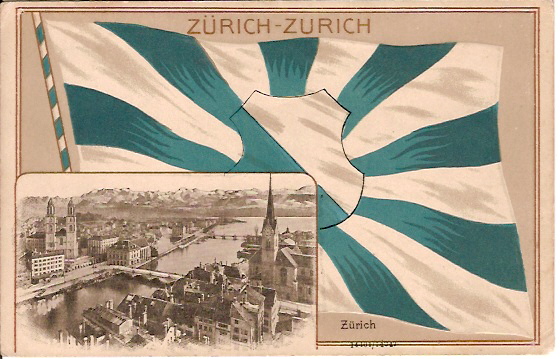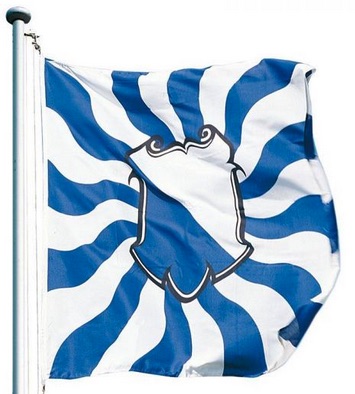Zürich canton (Switzerland) (original) (raw)
In 1273 Zurich's banner was adorned with a red "Schwenkel" ("chef" in French for lack of a better word), which is a very long pennon (see image). Conflicting reports put it at 1278 or 1348. This was regarded as a high honour and/or a mark of sovereignty, but there are conflicting reports from the Middle Ages that it was also a mark of shame (e.g. a sign that the previous banner had been lost in battle). After the battle of Nancy in 1477, the Duke of Lorraine removed the Schwenkels from Swiss banners saying they had erased their shame, but when the troops got home they restored the Schwenkels since they considered them marks of honour and not shame. A little white cross on the Schwenkel probably came with the original pennon. The Schwenkel very strongly resembles the flag of Schwyz or modern Switzerland, and other confederate states adopted it in the 15th century, but there is no documentation explaining its meaning for other states and no proof that it was a mark of the Confederacy.
Military flag, Republic of Zürich (In use until 1798 [before Helvetic Republic]). Drawing according to a contemporary drawing 1792 (see Swiss Cantons War and Military Flags).
Cantonal Banner of Zürich with red Schwenkel
[![[Cantonal banner of Zürich with red Schwenkel]](http://www.crwflags.com/fotw/images/c/ch-zh15.gif) ](../images/c/ch-zh15.gif)image by T.F. Mills
](../images/c/ch-zh15.gif)image by T.F. Mills
The Schwenkel, granted in 1273, may have influenced the development of the Swiss flag, but did not in of itself signify Zurich's membership in the Swiss Confederation.
T.F. Mills, 14 November 1997
See also: • SCHWENKEL in Dictionary of Vexillology
•Der Schwenkel (by Günter Mattern, ICV 15, 1993, German)
Colour Flag
[![[Colour Flag ZH]](http://www.crwflags.com/fotw/images/c/ch-zh_56.gif) ](../images/c/ch-zh%5F56.gif) image by Ole Andersen
](../images/c/ch-zh%5F56.gif) image by Ole Andersen
Rectangular cantonal flag, as shown in Kannik (1956)[So-called Farbenfahne (colour flag); in the case of ZH divided diagonally instead of horizontally].
Ole Andersen, 4 August 2002
See also: STATE COLOURS in Dictionary of Vexillology
| Flaggen, Knatterfahnen and Livery Colours | ||
|---|---|---|
[![[Knatterfahnen]](http://www.crwflags.com/fotw/images/c/ch-zh_f.gif) ](../images/c/ch-zh%5Ff.gif) ](../images/c/ch-zh%5Ff.gif) |
[![[Knatterfahnen]](http://www.crwflags.com/fotw/images/c/ch-zh_kf.gif) ](../images/c/ch-zh%5Fkf.gif) ](../images/c/ch-zh%5Fkf.gif) |
[![[livery colours]](http://www.crwflags.com/fotw/images/c/ch-zh_ff.gif) ](../images/c/ch-zh%5Fff.gif) ](../images/c/ch-zh%5Fff.gif) |
images by Pascal Gross
Flaggen are vertically hoisted from a crossbar in the manner of gonfanon, in ratio of about 2:9, with a swallowtail that indents about 2 units. The chief, or hoist (square part) usually incorporates the design from the coat of arms – not from the flag. The fly part is always divided lengthwise, usually in a bicolour, triband or tricolour pattern (except Schwyz which is monocolour, and Glarus which has four stripes of unequal width). The colours chosen for the fly end are usually the main colours of the coat of arms, but the choice is not always straight forward.
Knatterfahnen are similar to Flaggen, but hoisted from the long side and have no swallow tail. They normally show the national, cantonal or communal flag in their chiefs.
Željko Heimer, 16 July 2000
See also: HANGING FLAG, VERTICALLY HOISTED FLAG,LIVERY COLOURS in Dictionary of Vexillology
Early 20th Century Flag Design

 images located by Martin Karner
images located by Martin Karner
(source) (source)
At the beginning of the 20th century, flamed flags were still in use, with the white cross replaced by a (baroque) shield in the centre of the flag. These decorative flags had been used until WWII and then somewhat forgotten in preference of the current cantonal flags. [Today they are being produced again, see right image]
Pascal Gross, 30 June 2002
See also:
- National flag and other cantonal flags with "Early 20th century flag design"
- Modern flamed flags
- FLAMMES in Dictionary of Vexillology
Logo

(source)
Cockade
 image located by Martin Karner
image located by Martin Karner
(source)
Cockade for the cantonal troops' headgear (regulation from 1869, size: ca. 40 mm, reverse side).
Martin Karner, 14 March 2025
See also: Cockades (Swiss Army)